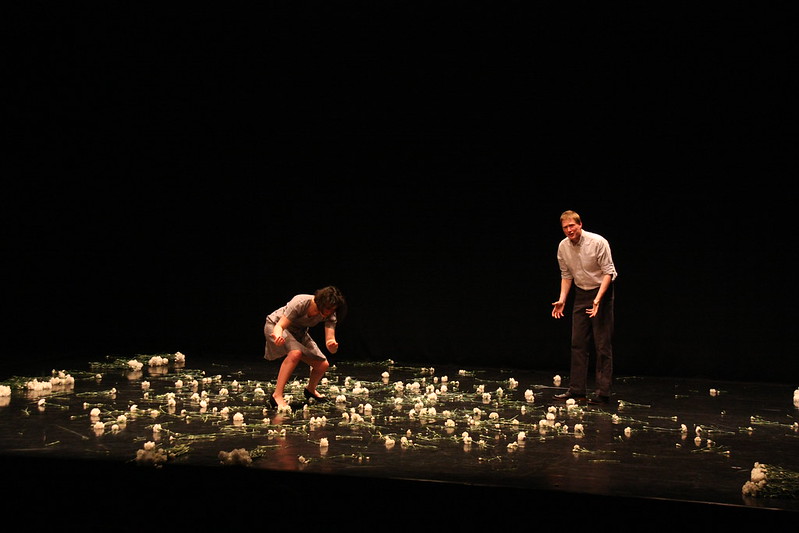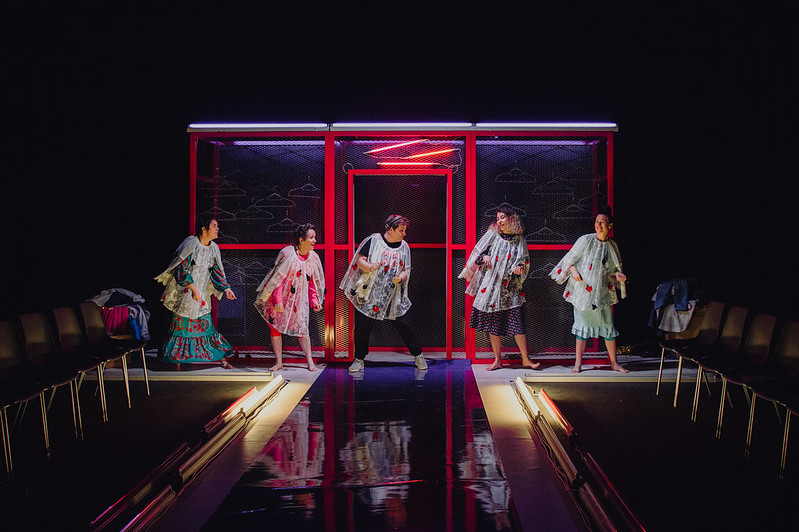Fronteiras | Interview with Two Destination Language
14th June 2022Fronteiras is a new performingborders series engaging in research on language, translation and cross-border working methodologies, tapping into how language and perception of cultural signifiers changes when working transnationally.
Two Destination Language are composed by Katherina Radeva, a Thracian woman from Bulgaria and Alister Lownie, a Scottish man. Together they explore multi-lingual and aesthestical approaches to performance, based on the experiences of both cross-cultural identities.
Katherina and Alister, welcome to PB. We have been following your work for a while, and are constantly admiring how you work across and from so many borders. Could you give us a brief description of your work and how it comes together in the rehearsal room?
Hello and thank you for having us. We are Kat and Alister from Two Destination Language. Very briefly, we make performance which sits on stages and tours extensively across the UK and internationally. We also make socially engaged work with different people in their often rural places and we also run a programme of peer to peer support called FIELD. FIELD is a paid conversational residency for interdisciplinary artists which tends to happen once a year and work opportunities for other support afterwards. So far there have been three and there are also three publications that have come out as a result of the residency focusing and foregrounding artists voices and ideas of change with care at the core of each publication.
In the rehearsal room, we use many different starting points: sounds, images, text, light, actions. There’s a phase of rehearsal which is about generating possibilities, and then there’s a need to reflect and edit and shape. Deciding on the form of a piece is usually quite late in our process; we aren’t often making for a particular kind of space or audience to begin with, but exploring ideas which eventually point us to the form.
One of the most thrilling aspects of your live performances is the multi-linguistic approach to performance. Often, your distinct mother-tongues are used to communicate the same story in different ways. Can you let us know as to why?
Language is very important in our work and to us. We think of language in many different ways – the obvious one being that we often use Bugarian (Kat’s mother tongue) and English (Alister is Scottish though). But we also think very carefully about the visual language of each work and -equally important – the physical language of each work. We are really very interested in work that doesn’t explain and fill in gaps. We kind of strive to make work which is in some ways unresolved and nuanced so as a viewer you can place your own experience into it. And language is often a really good tool of exploring boundaries and of exploring what might fall between the gaps and what might be able to fill the gaps in a different way.
And of course, language is difference. And we think celebrating difference is super important. Not always easy but necessary.
In each language we try to be very conscious of what we say explicitly, what we imply and what is left open for audience members to assume and question.
The why for us comes from the fact that we are ourselves very different from one another – from our cultures and languages, to upbringing: rules, expectations, values. The glue binding us, and all those differences, is conversation. Both within our work and in the conversations it gives rise to, we are interested in intercultural dialogue, and the ways in which conversation across and about difference helps forge new identities with better understanding of one another. Language is key to that.

How has it affected you, both as artists-makers and as sector-navigators, to create works that exist across languages?
That is a really interesting question because I am sure most of your readers will know that to foreground something across an existing boundary – whether that is language or politics or ways of doing things – that takes a lot of guts and determination and also inevitable risks. And I suppose for us, we have always been into innovation and experimentation and that comes with a lot of risk taking. And language is risk taking – it’s trying to reach across unknowns. Sometimes those risks pay off, and other times – they seemingly fail. And in the sometimes perceived failures though, there is so much learning and so it’s not a failure really – it’s an opportunity to rethink and find new ways to shape an idea.
Sector- navigators is such an interesting term. Kat is really resistant to align with sector navigating because it’s often so painful but the truth of course is that language comes into that too and of course every single interdependent artist does sector navigating every single moment. Speech acts can shift how we see or think about our world, and our work. They can be gentle or furious, offers or demands, and so many things between and beyond those.
Suppose for us – the sector navigating thing is very similar to the work we put on stage – we do stuff our way, inviting others to try it, to share it. And our way often seems to sit outside the norm. For us that is an exciting spot to often occupy.
Has there ever been a time where you felt audiences, or even other culture-workers, were somewhat ‘lost in translation’ in your work? Or that their perception of your work drastically deviated from its intent?
We are totally sure that both some audiences and some other culture-works are ‘lost in translation’ with our work but that is not a reason to stop pushing at the boundaries of innovation and experimentation because many are not. Many come to see the next thing and that feels like a real privilege. I remember one of the very first gigs we did with Near Gone which is performed in Bulgarian and English and someone asked us – why on earth we had made that choice when Kat’s English was perfectly good. And that is very telling isn’t it. But you can say that about anything. Why on Earth make another drawing of the sea when someone might say that Turner’s version was perfectly good? So, we kind of get back to the sense that we are looking for ways in which we “say” what we want to say in the way we want to say it and show it and hope that more people fall on the side of enquiry rather than – this is lost on me. Isn’t that what all culture and art tries to do?
We don’t fully understand many things but we try and get them and process them with curiosity and kindness before ‘I don’t get it and it’s making me uncomfortable that I don’t get it” – I mean isn’t that what all colonisers did and do? Eradicate that which is unknown – language and culture and custom being part of the unknown. Imposing one view of our world on others is the opposite of our quest. We sometimes think we artists are more like scientists than is often acknowledged. We love questions and uncertainties, because those are the spaces we work in. We love to find new approaches to those questions.
Also, there is a joy which comes from not understanding, and sitting with the certainty of not knowing, but trying to read what you can from work. We both really enjoy foreign language performance when there is enough in non-verbal languages to work with and create meanings. They might not be those intended by the creators, or those understood by the rest of the audience, but that’s exciting and revealing.

You have considerably worked in areas and countries where English isn’t the main language. What are the considerations for you as makers when thinking about the context of where the work is going to be shown?
Context is everything. Like, E V E R Y T H I N G! And it’s important to acknowledge that we, Kat and Alister, don’t always get it right. But we start from a belief that as artists and people we are curious about the places we go. We watch other work while we’re there, and speak with other artists and curators. We hope that sharing our work is part of a process of cultural exchange.
A very unhelpful politic of the British has been the legacies of the empire and the debris that has left behind. So when working in places where English is not a dominant language (and of course many people do speak it) we try to arrive with the willingness to meet and learn a bit of the local culture and to actually tune in and come having done a little research into the embodied and carried history and recent history of said place. Because cultural assumptions are really hard to put aside, and we think it’s kind of weird to say that you can come completely prepared – you really can’t. But you can try to meet people where they are at, not where you think they might be at or where they should be at. And again we come back to the other types of language in our work- the visual and the physical. Often, a lot in our work is said without words but with images.
What is next for Two Destination Language?
Next we are working on a couple of projects – a dance solo with Kat in it (which is being made with a group of female choreographers across this year) and a fairly large rural project across Britain. We are taking some time to plan those.. Oh, and Fault Lines is doing a run at the Edinburgh Fringe in August 2022 so if you are anywhere near – come and give it a watch!
Two Destination Language is led by Katherina Radeva and Alister Lownie – a Thracian woman from Bulgaria and a Scottish man. We make bold award-winning performance work which explores ideas of identity, belonging and boundaries. Our work tours in the UK and internationally and is touching, thought provoking and visually arresting. It can be seen on theatre stages, in village halls, in libraries, in galleries, in parks, along roads, in abandoned shops. We also create exhibitions, installations and print publications. Our projects working with non-professional members of the community have been transformative for those involved and for the places they live, shared with public audiences like any of our other work. Our curatorial projects take shape in festivals we produce and conversations we undertake. Dialogue is a key element in our working process. We foster dogs and make super rhubarb and ginger jam which we often share with other artists.
www.twodestinationlanguage.com
Twitter: @2destlang
Instagram: @2destlang